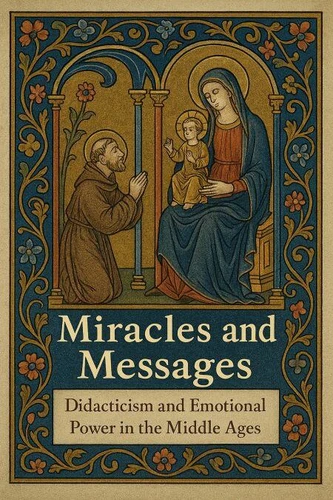Miracles and Messages: Didacticism and Emotional Power in the Middle Ages
Par :Formats :
Disponible dans votre compte client Decitre ou Furet du Nord dès validation de votre commande. Le format ePub est :
- Compatible avec une lecture sur My Vivlio (smartphone, tablette, ordinateur)
- Compatible avec une lecture sur liseuses Vivlio
- Pour les liseuses autres que Vivlio, vous devez utiliser le logiciel Adobe Digital Edition. Non compatible avec la lecture sur les liseuses Kindle, Remarkable et Sony
 , qui est-ce ?
, qui est-ce ?Notre partenaire de plateforme de lecture numérique où vous retrouverez l'ensemble de vos ebooks gratuitement
Pour en savoir plus sur nos ebooks, consultez notre aide en ligne ici
- FormatePub
- ISBN8230506423
- EAN9798230506423
- Date de parution01/04/2025
- Protection num.pas de protection
- Infos supplémentairesepub
- ÉditeurIndependently Published
Résumé
The Middle Ages were an era saturated with the supernatural. To the medieval mind, the world was not divided between the natural and the miraculous as it often is today. Rather, divine intervention, celestial signs, and wondrous events were woven seamlessly into the fabric of everyday life. Miracles were not seen as violations of natural law, but as divine corrections or reinforcements of a moral order too often obscured by human sin.
The miraculous was pedagogical-it taught, it warned, it moved. Miracles and messages were not merely stories for the faithful; they were the instruments by which the Church, chroniclers, mystics, and artists conveyed profound theological and ethical truths to a deeply hierarchical, yet emotionally invested society.
The miraculous was pedagogical-it taught, it warned, it moved. Miracles and messages were not merely stories for the faithful; they were the instruments by which the Church, chroniclers, mystics, and artists conveyed profound theological and ethical truths to a deeply hierarchical, yet emotionally invested society.
The Middle Ages were an era saturated with the supernatural. To the medieval mind, the world was not divided between the natural and the miraculous as it often is today. Rather, divine intervention, celestial signs, and wondrous events were woven seamlessly into the fabric of everyday life. Miracles were not seen as violations of natural law, but as divine corrections or reinforcements of a moral order too often obscured by human sin.
The miraculous was pedagogical-it taught, it warned, it moved. Miracles and messages were not merely stories for the faithful; they were the instruments by which the Church, chroniclers, mystics, and artists conveyed profound theological and ethical truths to a deeply hierarchical, yet emotionally invested society.
The miraculous was pedagogical-it taught, it warned, it moved. Miracles and messages were not merely stories for the faithful; they were the instruments by which the Church, chroniclers, mystics, and artists conveyed profound theological and ethical truths to a deeply hierarchical, yet emotionally invested society.






















